Immigrants from Northern Europe vs Slavic Disability Age 18 to 34
COMPARE
Immigrants from Northern Europe
Slavic
Disability Age 18 to 34
Disability Age 18 to 34 Comparison
Immigrants from Northern Europe
Slavs
6.5%
DISABILITY AGE 18 TO 34
64.1/ 100
METRIC RATING
167th/ 347
METRIC RANK
7.4%
DISABILITY AGE 18 TO 34
0.1/ 100
METRIC RATING
273rd/ 347
METRIC RANK
Immigrants from Northern Europe vs Slavic Disability Age 18 to 34 Correlation Chart
The statistical analysis conducted on geographies consisting of 475,061,054 people shows a mild positive correlation between the proportion of Immigrants from Northern Europe and percentage of population with a disability between the ages 18 and 35 in the United States with a correlation coefficient (R) of 0.358 and weighted average of 6.5%. Similarly, the statistical analysis conducted on geographies consisting of 270,473,270 people shows a significant positive correlation between the proportion of Slavs and percentage of population with a disability between the ages 18 and 35 in the United States with a correlation coefficient (R) of 0.692 and weighted average of 7.4%, a difference of 13.2%.

Disability Age 18 to 34 Correlation Summary
| Measurement | Immigrants from Northern Europe | Slavic |
| Minimum | 0.94% | 0.47% |
| Maximum | 58.3% | 90.5% |
| Range | 57.4% | 90.0% |
| Mean | 13.3% | 18.6% |
| Median | 7.6% | 9.3% |
| Interquartile 25% (IQ1) | 5.8% | 7.2% |
| Interquartile 75% (IQ3) | 17.8% | 16.9% |
| Interquartile Range (IQR) | 12.1% | 9.7% |
| Standard Deviation (Sample) | 13.1% | 23.2% |
| Standard Deviation (Population) | 12.9% | 23.0% |
Similar Demographics by Disability Age 18 to 34
Demographics Similar to Immigrants from Northern Europe by Disability Age 18 to 34
In terms of disability age 18 to 34, the demographic groups most similar to Immigrants from Northern Europe are Immigrants from Moldova (6.5%, a difference of 0.070%), Eastern European (6.5%, a difference of 0.080%), Russian (6.5%, a difference of 0.29%), Immigrants from Hungary (6.5%, a difference of 0.44%), and Immigrants from Bahamas (6.6%, a difference of 0.45%).
| Demographics | Rating | Rank | Disability Age 18 to 34 |
| Immigrants | Southern Europe | 72.5 /100 | #160 | Good 6.5% |
| Arabs | 72.3 /100 | #161 | Good 6.5% |
| South Africans | 71.7 /100 | #162 | Good 6.5% |
| Immigrants | Denmark | 71.7 /100 | #163 | Good 6.5% |
| Immigrants | Nigeria | 70.4 /100 | #164 | Good 6.5% |
| Immigrants | Hungary | 69.6 /100 | #165 | Good 6.5% |
| Eastern Europeans | 65.1 /100 | #166 | Good 6.5% |
| Immigrants | Northern Europe | 64.1 /100 | #167 | Good 6.5% |
| Immigrants | Moldova | 63.1 /100 | #168 | Good 6.5% |
| Russians | 60.2 /100 | #169 | Good 6.5% |
| Immigrants | Bahamas | 57.9 /100 | #170 | Average 6.6% |
| Bahamians | 55.5 /100 | #171 | Average 6.6% |
| Ghanaians | 54.7 /100 | #172 | Average 6.6% |
| Immigrants | Mexico | 54.1 /100 | #173 | Average 6.6% |
| Native Hawaiians | 50.0 /100 | #174 | Average 6.6% |
Demographics Similar to Slavs by Disability Age 18 to 34
In terms of disability age 18 to 34, the demographic groups most similar to Slavs are African (7.4%, a difference of 0.010%), Tsimshian (7.4%, a difference of 0.050%), Immigrants from Somalia (7.4%, a difference of 0.080%), European (7.4%, a difference of 0.13%), and Swiss (7.4%, a difference of 0.14%).
| Demographics | Rating | Rank | Disability Age 18 to 34 |
| German Russians | 0.1 /100 | #266 | Tragic 7.4% |
| Bangladeshis | 0.1 /100 | #267 | Tragic 7.4% |
| Portuguese | 0.1 /100 | #268 | Tragic 7.4% |
| Basques | 0.1 /100 | #269 | Tragic 7.4% |
| Belgians | 0.1 /100 | #270 | Tragic 7.4% |
| Swiss | 0.1 /100 | #271 | Tragic 7.4% |
| Tsimshian | 0.1 /100 | #272 | Tragic 7.4% |
| Slavs | 0.1 /100 | #273 | Tragic 7.4% |
| Africans | 0.1 /100 | #274 | Tragic 7.4% |
| Immigrants | Somalia | 0.1 /100 | #275 | Tragic 7.4% |
| Europeans | 0.1 /100 | #276 | Tragic 7.4% |
| Immigrants | Portugal | 0.1 /100 | #277 | Tragic 7.4% |
| Lumbee | 0.1 /100 | #278 | Tragic 7.4% |
| Czechoslovakians | 0.1 /100 | #279 | Tragic 7.4% |
| Yaqui | 0.1 /100 | #280 | Tragic 7.4% |